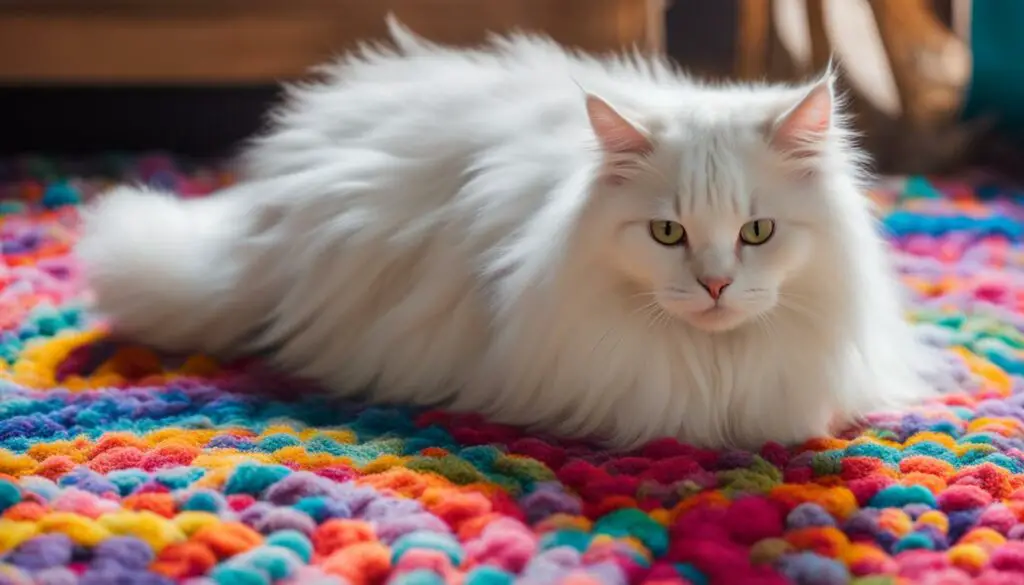When a cat has hair stuck in their bum, it can be a concerning issue. In this article, I will provide helpful tips and advice on how to handle this common feline problem. We will explore the causes, treatment options, and preventive measures to ensure your cat’s health and well-being.
Key Takeaways:
- Hair stuck in a cat’s bum can lead to a fur blockage, constipation, and anal gland issues.
- Grooming your cat regularly can help prevent hairballs and reduce the risk of hair getting stuck in their bum.
- If your cat has hair stuck in their bum, seek veterinary care for proper diagnosis and treatment.
- Preventive measures such as keeping your cat’s fur clean and providing a balanced diet can help maintain their overall health and hygiene.
- Consult with your veterinarian for specific grooming tips and techniques tailored to your cat’s needs.
What Is Pseudocoprostasis in Cats?
Pseudocoprostasis is a condition that commonly affects cats, particularly those with long hair. It occurs when fecal matter becomes matted in the hair surrounding the anal opening, leading to an obstruction. This obstruction can cause difficulties in defecation and may result in further health issues if not addressed promptly.
This condition is often seen in cats that have diarrhea, as the loose stool can easily become entangled in the fur. Longhaired cat breeds are more prone to pseudocoprostasis due to the nature of their fur. The fecal matter can become stuck in the hair, creating a blockage that inhibits proper elimination.
In addition to the discomfort and pain it causes the cat, pseudocoprostasis can also lead to complications such as skin irritations, infections, and even maggot infestation. Therefore, it is important for cat owners to be aware of the signs and symptoms of this condition and take appropriate measures to prevent and treat it.
| Common Causes of Pseudocoprostasis in Cats |
|---|
| Diarrhea |
| Long hair |
“Pseudocoprostasis is a condition that commonly affects cats, particularly those with long hair.”
Symptoms of Pseudocoprostasis in Cats
Cats with pseudocoprostasis may exhibit several symptoms that indicate the presence of fecal matter matted around the anus. These symptoms include:
- Straining to defecate
- Scooting their bottom across the floor
- Vomiting
- Poor appetite
- Lethargy
- Foul odor
If you notice any of these signs in your cat, it is important to seek veterinary attention for a proper diagnosis and treatment. Early intervention can help prevent further complications and discomfort for your furry friend.

Symptoms of Pseudocoprostasis in Cats
When a cat has pseudocoprostasis, there are several symptoms to look out for. These signs can indicate the presence of fecal matter matted around the anus and potential complications from the condition. If you notice any of these symptoms in your cat, it is important to seek veterinary attention for proper diagnosis and treatment.
Straining to Defecate
One common symptom of pseudocoprostasis is straining to defecate. Cats may appear to be in discomfort and make repeated attempts to empty their bowels. This straining can be a result of the obstruction caused by the matted fecal matter, making it difficult for the cat to pass stool.
Scooting Bottom Across the Floor
Another symptom to watch for is when a cat scoots their bottom across the floor. This behavior is their way of trying to relieve the discomfort caused by the matted feces. It can be a clear indication that there is an issue with their anal area that needs to be addressed.
Vomiting, Poor Appetite, Lethargy, and Foul Odor
In addition to straining and scooting, cats with pseudocoprostasis may also exhibit other symptoms such as vomiting, poor appetite, lethargy, and a foul odor. These signs can be a result of the discomfort and potential complications associated with the condition. If your cat shows any of these symptoms, it is crucial to consult a veterinarian for a proper evaluation and treatment plan.
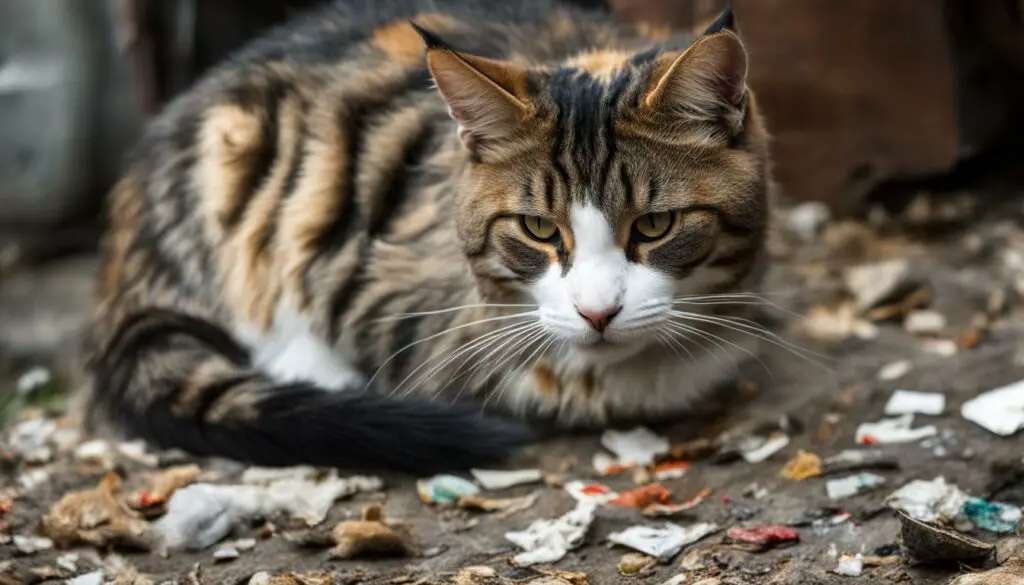
Diagnosis and Treatment of Pseudocoprostasis in Cats
Diagnosing pseudocoprostasis in cats typically involves a physical examination. During the examination, the veterinarian will look for a large mass of fecal and hair obstructing the cat’s anal opening. This observation confirms the presence of pseudocoprostasis. Additionally, stool sample evaluation may be performed to check for any underlying intestinal parasites. In some cases, the presence of maggots may also need to be addressed and removed.
The treatment of pseudocoprostasis involves shaving the anal area to remove the matted hair and fecal mass. This helps to alleviate the obstruction and relieves discomfort for the cat. The veterinarian may also provide medical treatment to soothe any irritation in the affected area. It’s important to note that home care and prevention play a crucial role in the overall treatment and management of pseudocoprostasis.
Home Care and Prevention
After the mass is removed and the cat has received veterinary treatment, it is important to maintain proper home care to prevent a recurrence. Regularly cleaning the anal area with mild soap and warm water can help keep the area clean and free from any residual debris. Seeking the assistance of a professional groomer to trim the hair around the anus can also help reduce the risk of future matting.
Prevention strategies include keeping the cat’s environment free from string-like objects that could be ingested, as well as providing appropriate cat toys that are safe for play. Monitoring the cat for any signs of gastrointestinal distress, such as vomiting or changes in appetite, is also important. By implementing these preventive measures, cat owners can help minimize the chances of their cat developing pseudocoprostasis.
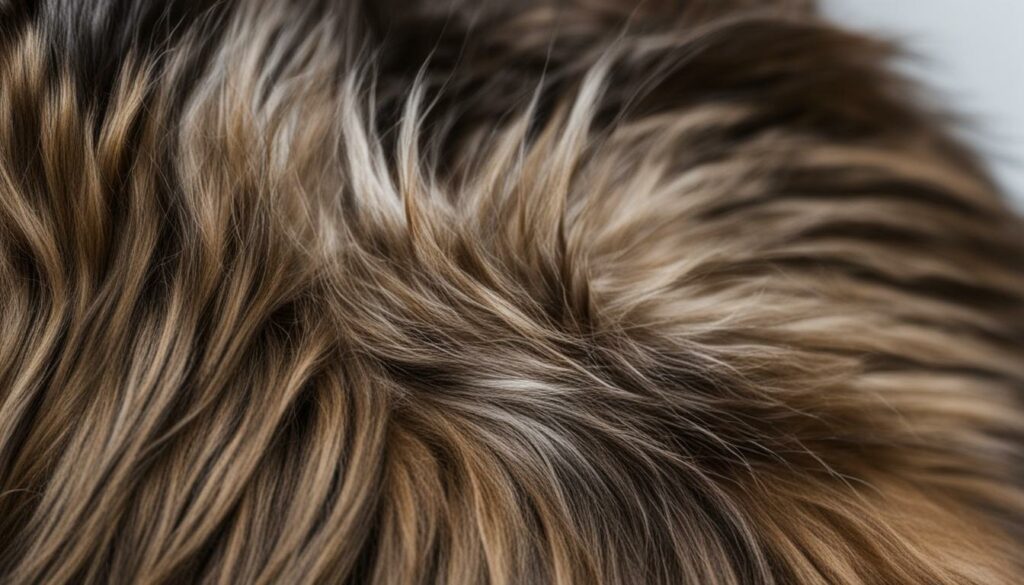
| Treatment Methods | Benefits |
|---|---|
| Shaving the anal area | Removes the matted hair and fecal mass, relieving the obstruction and discomfort for the cat |
| Medical treatment for irritation | Provides relief from any inflammation or irritation in the affected area |
| Stool sample evaluation | Allows for the detection of any underlying intestinal parasites |
| Removal of maggots | Addresses any complications arising from maggot infestation |
Should You Pull the String Coming Out of Your Cat’s Bum?
When you notice a string coming out of your cat’s bum, you may be tempted to pull it out yourself. However, it is important to consider the potential risks before taking any action. Pulling a string without proper knowledge and guidance can result in further complications for your furry friend.
It is highly recommended to seek veterinary evaluation and assistance before attempting to remove the string. A veterinarian can assess the situation, determine the best course of action, and ensure the safety and well-being of your cat. They have the necessary expertise and tools to handle the situation effectively.
There are specific situations in which pulling the string may be safe, such as when the string is easily accessible and visible without causing any discomfort to your cat. However, even in these cases, it is crucial to know when to stop pulling. If there is any resistance or if the string appears to be wrapped around something inside the intestines, pulling should be stopped immediately, and professional veterinary care should be sought.
| Potential Risks of Pulling the String Yourself | Veterinary Evaluation and Assistance |
|---|---|
| Possible damage to the intestinal tract | Expertise and knowledge of professionals |
| Risk of causing pain or discomfort to your cat | Safety and well-being of your cat |
| Potential complications from improper removal | Proper assessment and treatment |
Remember, the health and safety of your cat should always be your top priority. If you notice a string coming out of your cat’s bum, seek veterinary evaluation and guidance to ensure the best outcome for your furry companion.
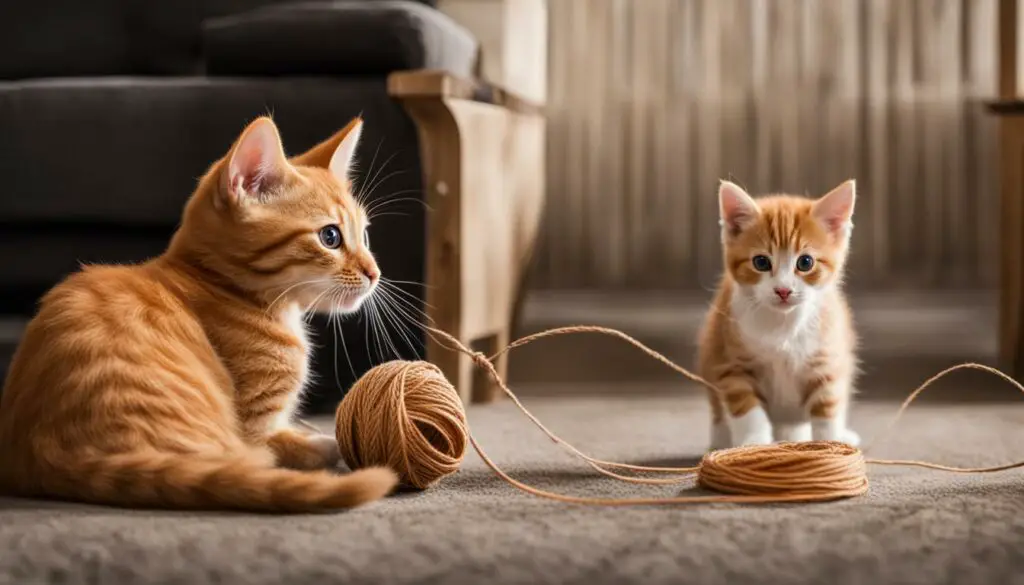
String-Like Things Cats Like to Swallow
Cats have a curious nature and are known to engage in playful behavior. Sometimes, this curiosity can lead them to swallow string-like items, which can pose serious dangers to their health. Here are some common string-like items that cats may swallow:
- Yarn
- Sewing thread
- Cords
- Ribbons
- Tinsel
- Fishing line
- Elastic bands
- Plastic bags
It’s important to understand the potential risks associated with these items and take preventive measures to keep them out of your cat’s reach. Ingesting string-like objects can lead to serious complications, such as intestinal blockages, which may require surgical intervention.
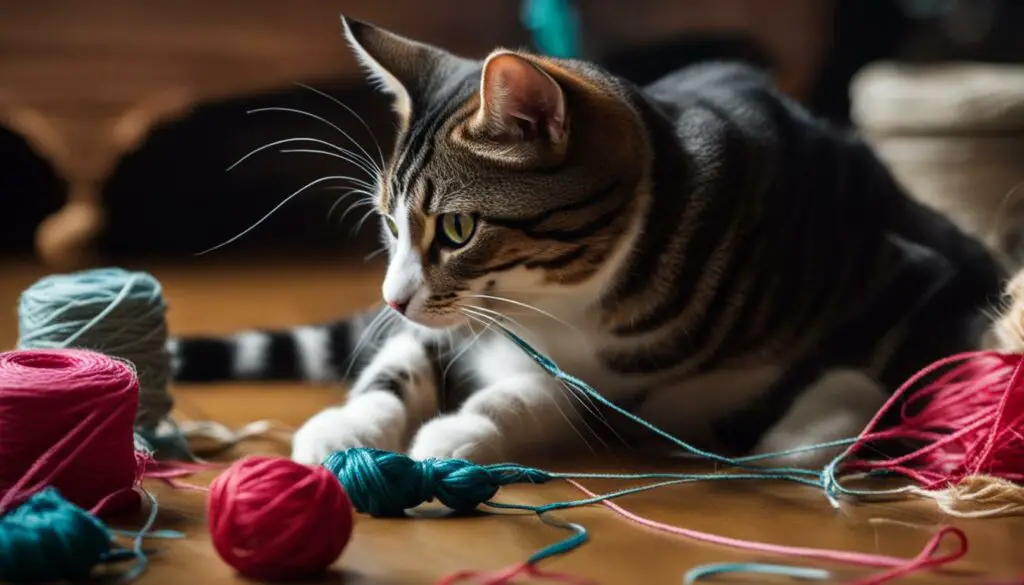
“As a responsible cat owner, it is crucial to create a safe environment for your feline friend. Keep these string-like items securely stored away and dispose of them properly. Regularly inspect your home for any potential hazards and remove them promptly. By taking these preventive measures, you can help protect your cat from the dangers of ingesting string-like objects.”
When Should You Call a Veterinarian?
If your cat has swallowed a string-like item or is experiencing complications related to hair stuck in their bum, it is important to know when to call a veterinarian. While some situations may be manageable at home, certain symptoms and scenarios require immediate veterinary attention to ensure the health and well-being of your furry friend.
If you observe any of the following symptoms, it is crucial to seek veterinary guidance:
- Decreased appetite
- Vomiting
- Lethargy
- Signs of pain or discomfort
- Unusual behavior or distress
These signs may indicate complications or potential obstructions caused by the string or hair blockage. It is always better to err on the side of caution and consult a veterinarian for a professional evaluation. They will be able to provide the appropriate treatment and advice tailored to your cat’s specific situation.
| Symptoms | When to Call a Veterinarian |
|---|---|
| Decreased appetite | Contact a veterinarian if your cat has not eaten for more than 24 hours. |
| Vomiting | If your cat is repeatedly vomiting or unable to keep any food down, seek veterinary attention. |
| Lethargy | If your cat is unusually lethargic and lacks energy, it is best to consult a veterinarian. |
| Signs of pain or discomfort | Any indication of pain or distress warrants immediate veterinary care. |
| Unusual behavior or distress | If your cat is displaying abnormal behavior or appears to be in distress, contact a veterinarian to assess the situation. |
Remember, your veterinarian is your best resource when it comes to your cat’s health. They can provide the necessary guidance, perform any required diagnostic tests, and offer appropriate treatment options. It is always better to seek professional help early on to prevent any complications and ensure your cat’s well-being.
How to Prevent Your Cat from Swallowing String-Like Things
Preventing your cat from swallowing string-like items is essential for their safety and well-being. By cat-proofing your home, providing safe cat toys, and supervising your cat during playtime, you can minimize the risk of ingesting harmful objects. Here are some tips:
Create a Cat-Friendly Environment
- Secure loose strings or cords, such as those from window blinds or curtains, to prevent your cat from playing with them.
- Keep sewing supplies, yarn, ribbons, and other string-like items stored securely in closed containers or drawers.
- Ensure electrical cords are hidden or covered to deter your cat from chewing on them.
Provide Safe Cat Toys
- Choose toys specifically designed for cats, such as interactive puzzle toys, treat dispensers, and catnip-filled plush toys.
- Avoid toys with string-like attachments that could easily detach or be swallowed.
- Rotate and diversify your cat’s toy selection to keep them engaged and entertained.
Supervise Your Cat During Playtime
- Engage in interactive play sessions with your cat using wand toys or laser pointers.
- Monitor your cat’s play to ensure they don’t accidentally swallow any parts of their toys.
- Store toys in a safe place when not in use to prevent your cat from accessing them unsupervised.
By following these preventive measures, you can significantly reduce the risk of your cat swallowing string-like things. Remember, creating a cat-friendly environment, providing safe toys, and maintaining supervision during playtime are key to keeping your cat happy, healthy, and string-free!
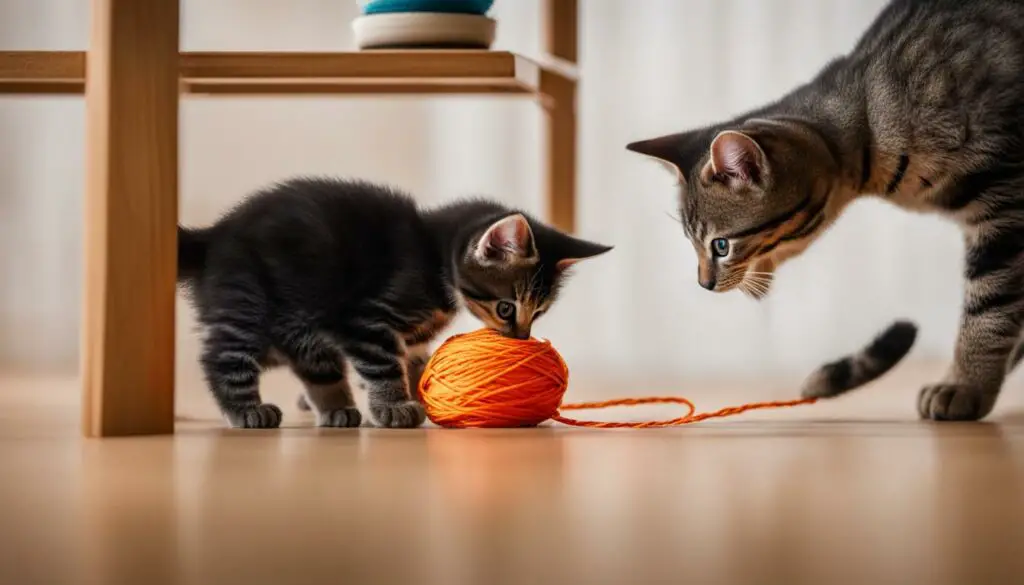
To Pull or Not to Pull a String? That is the Question!
When faced with the dilemma of a string stuck in your cat’s anus, it’s important to make an informed decision about whether or not to attempt removal. While gentle and slow tugging may be a viable option, there are potential risks to consider. It’s crucial to be aware of the signs of complications and know when to stop pulling and seek veterinary care.
Before attempting to remove the string, ensure that the cat is held securely by someone else to prevent them from running off. Start with a gentle tug, but if you encounter any resistance or if the string is wrapped around something inside the intestines, it’s essential to stop immediately. Pulling further can lead to severe complications and damage to the cat’s delicate anatomy.
“Gentle and slow tugging may be a viable option, but be aware of the signs of complications and know when to stop pulling and seek veterinary care.”
If you notice any signs of complications while attempting to remove the string, such as bleeding, increased pain, or distress, it’s crucial to seek veterinary evaluation. A veterinarian will have the necessary expertise and tools to handle the situation properly and minimize any potential harm to your cat.
Safely Cut the String From Your Cat’s Bum
If you’ve determined that it’s safe to remove the string from your cat’s bum, you can use scissors to carefully cut the protruding portion. However, it’s important to exercise caution and take necessary precautions to ensure your cat’s safety throughout the process.
Here are some essential steps to follow when cutting the string:
- Make sure you have a pair of clean, sharp scissors that are suitable for cutting the string. Dull or dirty scissors can cause injury or introduce bacteria into the wound.
- Hold your cat securely to prevent any sudden movements or escapes while you’re cutting the string. It’s best to have someone else assist you during this process.
- Gently and slowly cut the protruding portion of the string, being careful not to cut the tail or rectum. Take your time and make precise cuts to avoid accidental injuries.
- After cutting the string, place it in a clean container or bag. It’s important to bring this cut portion to your veterinarian for evaluation.
Remember, if you encounter any resistance or signs of complications while cutting the string, it’s crucial to stop immediately and seek veterinary evaluation. Your veterinarian can provide further guidance and determine the most appropriate course of action for your cat’s specific situation.
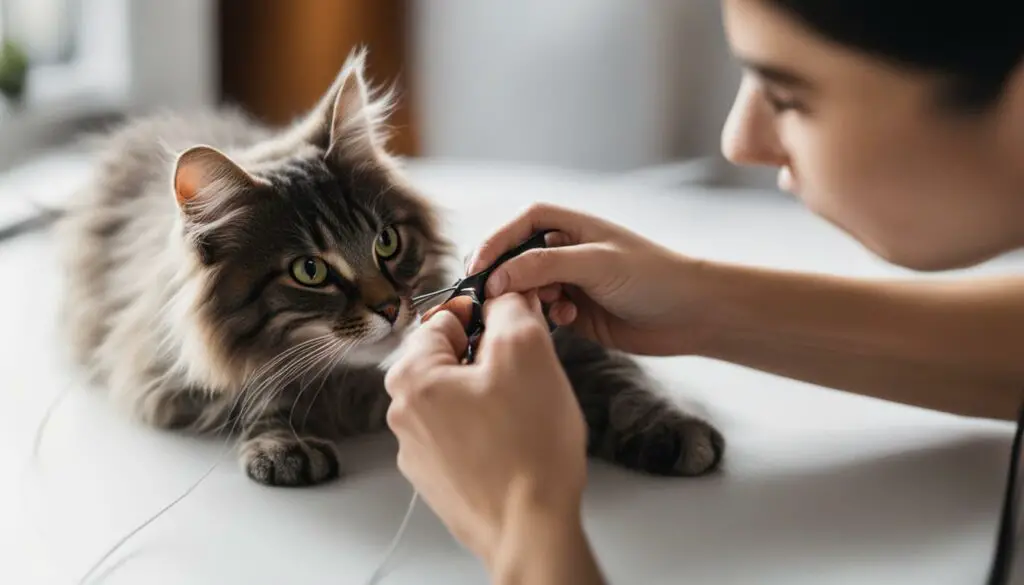
| Precautions | Scissors | Bringing Cut Portion to the Vet |
|---|---|---|
| Use clean and sharp scissors to avoid infection or injury. | Choose scissors specifically designed for cutting string or similar materials. | Place the cut portion of the string in a clean container or bag to bring to your veterinarian for evaluation. |
| Hold your cat securely to prevent any sudden movements or escapes. | Make precise cuts to avoid accidental injuries to your cat’s tail or rectum. | This allows your veterinarian to assess the material and determine the best course of action. |
| Stop immediately if you encounter resistance or signs of complications. | Ensure the scissors are clean and free of any potential contaminants. | Bringing the cut portion helps your veterinarian make informed decisions regarding your cat’s care. |
When to Seek Veterinary Attention and Treatment
If your cat has ingested a string-like item or is experiencing complications related to hair stuck in their bum, it is necessary to seek veterinary attention. A veterinarian is equipped to provide the appropriate evaluation and treatment for your cat’s specific situation. They may perform diagnostic tests such as x-rays or ultrasounds to detect any internal complications that may have arisen from the ingested string or the presence of hair stuck in the bum.
During the veterinary evaluation, the detection of complications will guide the recommended course of action. In some cases, surgical treatment may be necessary to remove any obstructions caused by the string or hair. It is important to follow the veterinarian’s guidance and advice regarding post-operative care and any home care recommendations they provide.
While seeking veterinary attention and treatment is crucial, it is also important to be proactive in preventing such incidents from occurring again in the future. Taking preventive measures, such as ensuring the absence of string-like items within your cat’s reach, can significantly reduce the risk of them ingesting these objects. Regular grooming and close monitoring of your cat’s overall health and well-being are also essential to catch any potential issues early on.
| Veterinary Evaluation and Treatment | Prevention and Monitoring |
|---|---|
| – X-ray and ultrasound tests | – Keep string-like objects out of reach |
| – Detection of complications | – Regular grooming to prevent excessive hair ingestion |
| – Surgical treatment if necessary | – Close monitoring of cat’s health |
| – Home care recommendations | – Prompt action in case of any concerning symptoms |
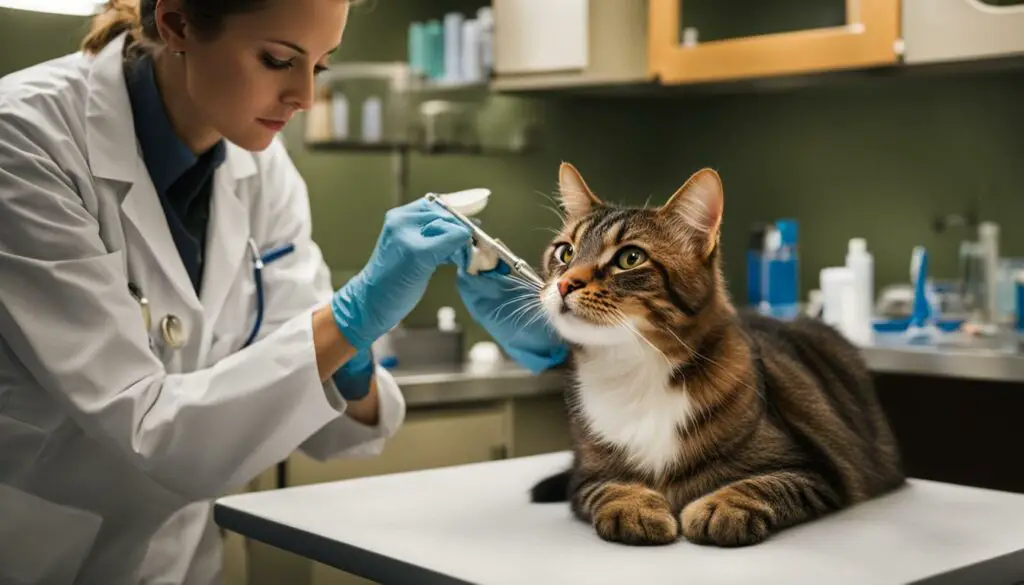
“The key to maintaining your cat’s health and preventing complications is to be proactive in seeking veterinary attention and treatment when needed. By doing so, you can ensure that your feline companion receives the appropriate care and support for their specific condition.” – Dr. Smith, Veterinarian
Is It Safe to Leave the String in and Wait for It to Pass?
When faced with the dilemma of a string stuck in your cat’s bum, you might wonder if it’s safe to leave it and wait for it to pass naturally. While this may seem like a convenient option, there are potential risks and considerations to keep in mind.
Monitoring your cat’s condition closely is crucial if you choose to wait for the string to pass. Look out for warning signs such as decreased appetite, vomiting, or signs of pain. These symptoms could indicate complications or blockage caused by the string. If you notice any concerning signs, it is important to seek immediate veterinary care.
Leaving a string in your cat’s bum for an extended period can lead to various complications. The string may cause skin irritations, infections, or even attract maggots. Additionally, it can obstruct bowel movements and lead to dehydration or electrolyte imbalances. It’s vital to prioritize your cat’s health and not delay seeking veterinary attention if necessary.
Remember, the string may not pass naturally on its own, and attempting to remove it without proper knowledge and guidance can cause more harm than good. Your veterinarian will be able to evaluate the situation and provide the appropriate treatment and care for your cat’s specific needs.
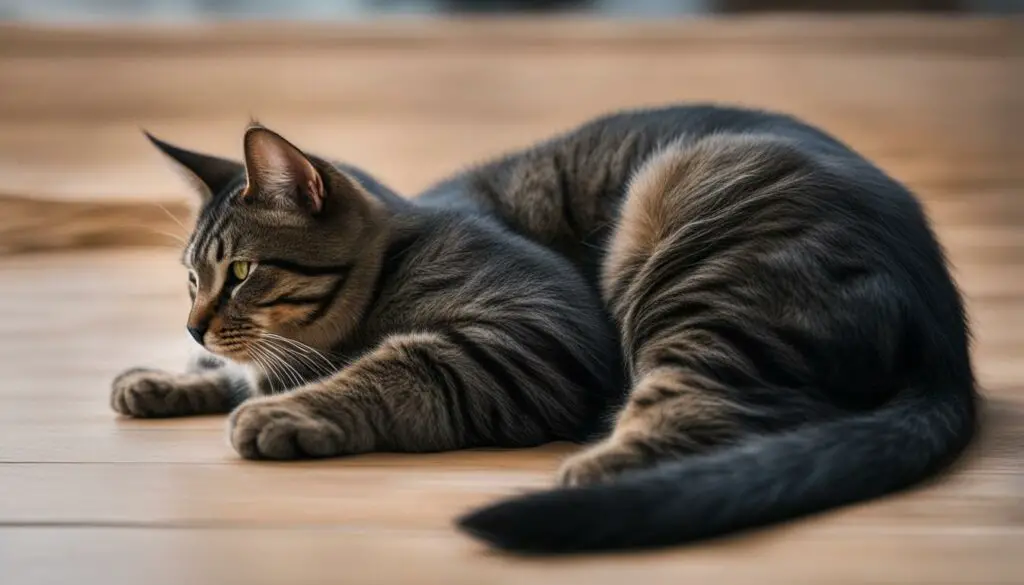
Table: Risks and Potential Complications of Leaving String in Cat’s Bum
| Risks | Potential Complications |
|---|---|
| 1. Skin irritations | 1. Skin infections |
| 2. Infections | 2. Maggot infestation |
| 3. Obstruction of bowel movements | 3. Dehydration |
| 4. Dehydration | 4. Electrolyte imbalances |
Leaving the string to pass naturally should only be considered as a last resort under veterinary guidance. It is crucial to prioritize your cat’s health by seeking immediate veterinary care if any warning signs or complications arise. Your veterinarian will provide the necessary treatment and support to ensure your cat’s well-being.
Home Care After Removing String From Cat’s Bum
After successfully removing the string from your cat’s bum, it is essential to provide proper post-removal care to ensure their comfort and promote healing. Cleaning the anal area with warm water and mild dish soap is an important step in maintaining hygiene and preventing infections. Gently wet a cloth or cotton ball with the soapy water and carefully clean around the anus, removing any residual fecal material.
Seeking the assistance of a professional groomer can be beneficial in maintaining the area and preventing reoccurrence. A groomer can help clip the hair around the anus, minimizing the likelihood of hair becoming matted and causing further issues. Regular cleaning and grooming can significantly reduce the risk of hair getting stuck in your cat’s bum, ensuring their overall health and well-being.
Preventing reoccurrence is crucial, and there are several steps you can take to avoid this problem in the future. Regular cleaning of the anal area, especially for long-haired cats, can prevent the accumulation of fecal matter and hair. Additionally, you should monitor your cat’s grooming habits, ensuring they are adequately grooming themselves and not ingesting excessive amounts of hair.
Remember to consult with your veterinarian for personalized recommendations and advice on post-removal care for your cat. They can provide additional insights based on your cat’s specific needs and help ensure their long-term health and well-being.
Post-Removal Care Checklist:
- Clean the anal area with warm water and mild dish soap.
- Seek the assistance of a professional groomer to clip the hair around the anus.
- Regularly monitor and clean the anal area to prevent reoccurrence.
- Consult with your veterinarian for personalized advice and recommendations.
By following these post-removal care guidelines and taking preventive measures, you can help keep your cat’s bum clean and free from obstructions. Remember, your veterinarian is always the best resource for specific guidance and care tailored to your cat’s individual needs.

Potential Complications and Risks of Hair Stuck in Cat’s Bum
When a cat has hair stuck in their bum, it can lead to various complications and risks that can impact their overall health and well-being. One common complication is skin irritations, which can occur due to the constant presence of matted hair around the anus. This can cause discomfort and itching for the cat, leading to excessive scratching and further irritation of the skin. If left untreated, these skin irritations can progress to infections, which can be painful and require medical intervention.
Another potential risk of hair stuck in a cat’s bum is the possibility of maggot infestation. When fecal matter becomes trapped in the matted hair, it creates a warm and moist environment that is attractive to flies. These flies can lay eggs in the affected area, leading to the hatching of maggots. Maggot infestation can cause severe discomfort and pain for the cat, and immediate veterinary attention is necessary to prevent further complications.
Matted hair in a cat’s bum can also result in dehydration and electrolyte imbalance. The hairblockage can obstruct the normal passage of feces and hinder the cat’s ability to defecate. This can lead to decreased water intake and the accumulation of toxins in the body. Dehydration and electrolyte imbalance can have serious consequences for a cat’s health and require prompt veterinary treatment.
To prevent these complications, it is important to address hair stuck in a cat’s bum promptly. Regular grooming, including trimming the hair around the anus, can help prevent the formation of mats and reduce the risk of blockage. It is also essential to monitor your cat’s litter box habits and seek veterinary attention at the first sign of any issues. By being proactive in caring for your cat’s hygiene and addressing potential problems early on, you can ensure their continued health and well-being.
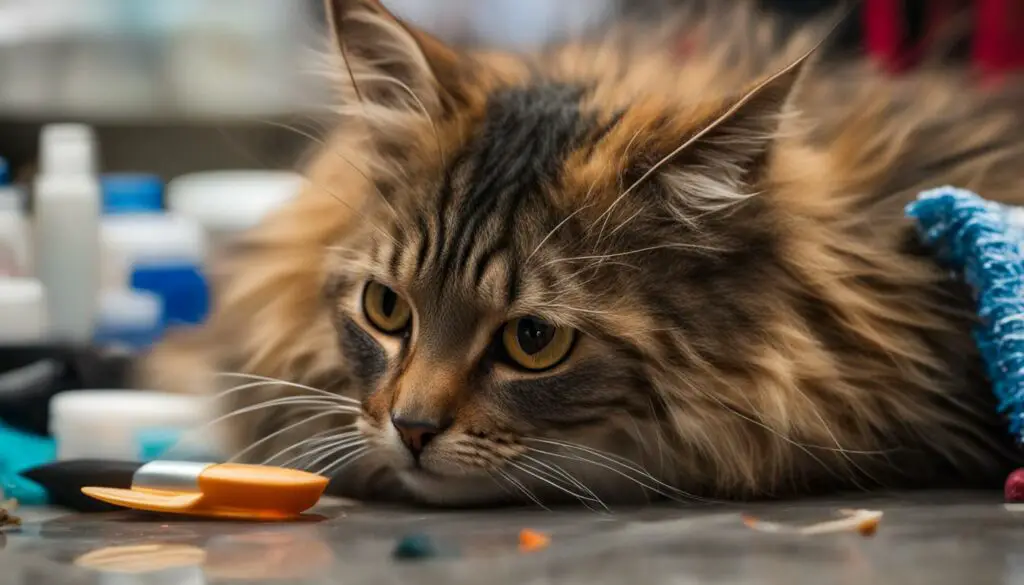
Potential Complications and Risks of Hair Stuck in Cat’s Bum
| Complication | Description |
|---|---|
| Skin irritations | Constant presence of matted hair can lead to discomfort, itching, and excessive scratching, which can result in skin irritations. |
| Infections | Untreated skin irritations can progress to infections, causing pain and requiring medical intervention. |
| Maggot infestation | Fecal matter trapped in matted hair can attract flies, leading to the infestation of maggots, which can be painful and require immediate veterinary attention. |
| Dehydration and electrolyte imbalance | Hair blockage can obstruct normal defecation, leading to decreased water intake and the accumulation of toxins, resulting in dehydration and electrolyte imbalance. |
Importance of Preventive Care and Regular Grooming for Cats
As a cat owner, I understand the vital role that preventive care and regular grooming play in keeping our feline friends healthy and happy. Cat grooming goes beyond just keeping their coat looking beautiful; it is a fundamental aspect of their overall well-being. Regular brushing not only helps to prevent excessive hair ingestion and the formation of hairballs but also allows for early detection of any abnormalities, such as matted hair or skin irritations.
Preventive care, including routine grooming, provides numerous benefits for our cats. It allows us to maintain their hygiene, manage shedding, and promote a healthy coat. Brushing helps to remove loose hair and debris, preventing it from getting stuck in sensitive areas like their bum. By keeping their fur clean and tangle-free, we minimize the risk of complications such as pseudocoprostasis, where fecal matter becomes matted in the hair around the anus.
Close monitoring of our cats’ grooming needs allows us to address any issues promptly. Regular brushing sessions give us the opportunity to examine their skin for any signs of irritation, wounds, or parasites. Being proactive in our cat’s grooming routine helps us detect potential problems early on, preventing them from escalating into more significant health issues. Maintaining a clean and healthy coat also contributes to a cat’s overall comfort and well-being.
In addition to brushing, it’s important to provide other aspects of preventive care for our cats, such as regular veterinary check-ups, proper nutrition, and a clean living environment. Regularly monitoring their weight, dental health, and overall behavior enables us to identify any changes or potential health concerns. By integrating preventive care and regular grooming into our cat’s routine, we can ensure that they live their best, healthiest lives.
FAQ
What is pseudocoprostasis in cats?
Pseudocoprostasis is a condition where fecal matter becomes matted in the hair around a cat’s anus, leading to potential obstruction and health issues.
What are the symptoms of pseudocoprostasis in cats?
Symptoms may include straining to defecate, scooting their bottom across the floor, vomiting, poor appetite, lethargy, and a foul odor.
How is pseudocoprostasis diagnosed and treated?
Diagnosis is typically based on a physical examination, and treatment involves shaving the anal area and providing medical treatment for irritation. Stool samples may be evaluated, and maggots may need to be removed.
Should I pull the string coming out of my cat’s bum?
It is recommended to seek veterinary evaluation and guidance before attempting to remove the string to avoid potential risks.
What are some string-like things cats like to swallow?
Cats may swallow yarn, sewing thread, cords, ribbons, and other similar objects.
When should I call a veterinarian?
If your cat has swallowed a string-like item or is experiencing complications, such as decreased appetite, vomiting, lethargy, or signs of pain, immediate veterinary attention should be sought.
How can I prevent my cat from swallowing string-like things?
Cat-proof your home, keep potentially dangerous objects out of reach, provide safe cat toys, and supervise your cat during playtime to minimize the risk of ingestion.
Should I pull the string from my cat’s anus?
Proceed with a gentle and slow tug only if it is safe to do so. Stop pulling if there is any resistance or signs of complications, and seek veterinary evaluation.
How can I safely cut the string from my cat’s bum?
If it is safe, use scissors to cut the protruding portion of the string before taking your cat to the vet. Exercise caution to avoid cutting the tail or rectum.
When should I seek veterinary attention and treatment?
If your cat has ingested a string-like item or is experiencing complications, it is necessary to seek veterinary attention. X-rays or ultrasound may be done, and surgery may be required in some cases.
Is it safe to leave the string in and wait for it to pass?
It is essential to be vigilant and aware of potential risks. Monitor your cat closely, and if any concerning symptoms arise, immediate veterinary care should be sought.
What home care should I provide after removing the string from my cat’s bum?
Clean the anal area with warm water and mild dish soap, seek a professional groomer to clip the hair, and maintain regular cleaning and preventive measures.
What are the potential complications and risks of hair stuck in a cat’s bum?
Complications may include skin irritations, infections, maggot infestation, dehydration, and electrolyte imbalance.
Why is preventive care and regular grooming important for cats?
Regular grooming helps prevent hair ingestion and allows for early detection of abnormalities. Close monitoring of your cat’s overall health and grooming needs contributes to their well-being.

